Land and Oceans | Term 1 Unit 2 | Geography | 6th Social Science - Oceans | 6th Social Science : Geography : Term 1 Unit 2 : Land and Oceans
Chapter: 6th Social Science : Geography : Term 1 Unit 2 : Land and Oceans
Oceans
Oceans
The Earth looks blue
when we see it from space. This is because, two-thirds of it is covered by water.
The water is found in oceans and seas. Oceans are vast expanse of water. Seas are
water bodies partially or fully enclosed by land. As you have studied previously,
there are five main oceans in the world.
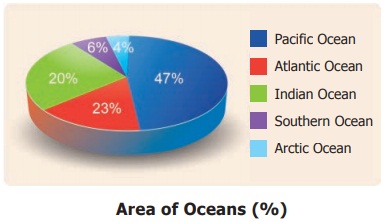
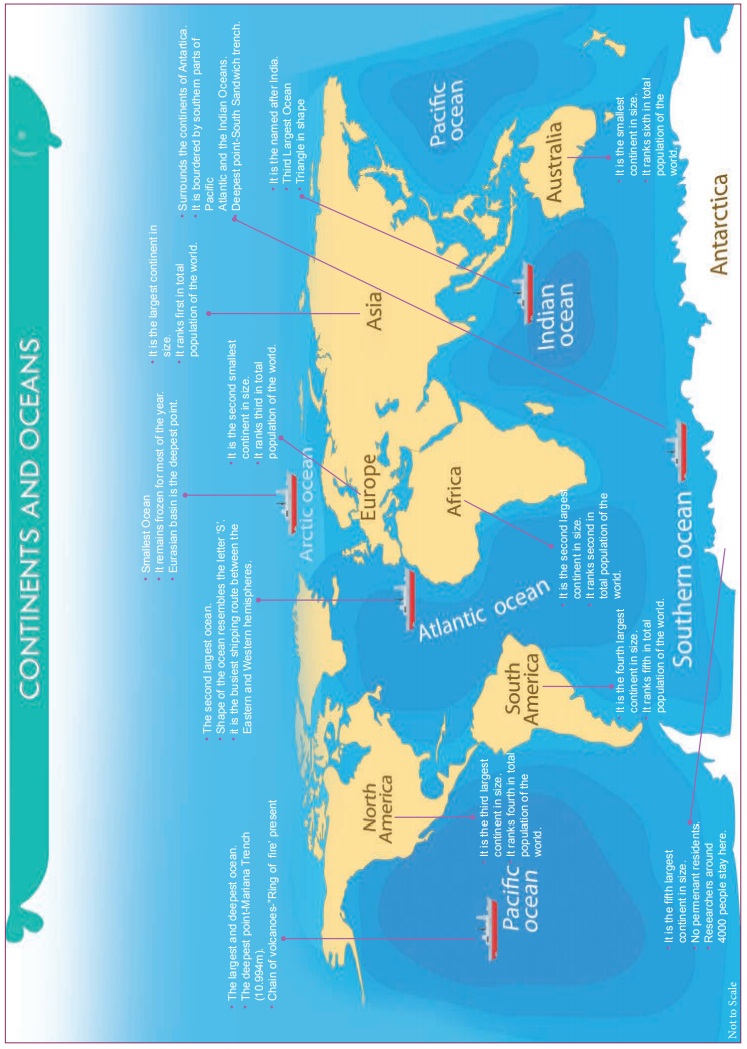
1. The Pacific Ocean
The Pacific Ocean is
the largest and deepest ocean on the Earth. It covers about one-third
of the Earth’s total area and spreads for about 168.72 million sq.km.
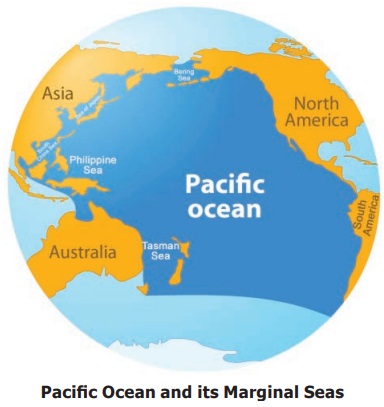
It is bounded by Asia
and Australia in its west and North America and South America in its east. It stretches
from the Arctic Ocean in the north to the Southern Ocean in the south.
If Mount
Everest, which is the highest
point (8,848 metres)was plugged into the Mariana Trench, still there would
be 2,146 metres of water left. The depth in meters from mean sea level is denoted
as m-
This ocean’s shape is
roughly triangular with its apex in the north at the Bering Strait which connects
the Pacific Ocean with the Arctic Ocean. The Bering Sea, the China Sea, the Sea
of Japan, Tasman Sea and the Philippine Sea are some of the marginal seas of the
Pacific Ocean. Indonesia, Philippines, Japan, Hawaii, New Zealand are some of the
islands located in this Ocean. The deepest point Mariana Trench is 10,994
m- and is located in the Pacific Ocean. A chain of volcanoes is located around the
Pacific Ocean called the Pacific Ring of Fire.
The Spanish navigator Ferdinand Magellan named the ocean Pacific, meaning calm or tranquil.
2. The Atlantic Ocean
The Atlantic Ocean is
the second largest ocean on the Earth. It covers one sixth of the Earth’s total
area and spreads for about 85.13 million sq.km . It is bounded by North America
and South America in the west and Europe and Africa in the east. Like the Pacific,
it stretches from the Arctic Ocean in the north to the Southern Ocean in the south.
The shape of the Atlantic Ocean resembles the letter ‘S’. The Strait of Gibraltar
connects the
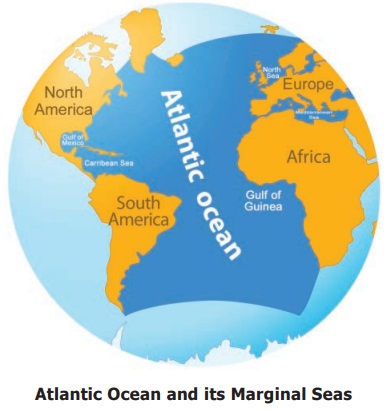
Atlantic Ocean with
the Mediterranean Sea. The Atlantic Ocean is the busiest shipping route between
the Eastern and Western hemispheres. The deepest point is the Milwaukee Deep
in the Puerto Rica Trench. It has a depth of about 8600 m-.
The Caribbean Sea, the Gulf of Mexico, the North Sea, the Gulf of Guinea and the
HOTS:
Why are the Red Sea, Dead Sea
and Black Sea named so?
Mediterranean Sea are
important marginal seas of the Atlantic Ocean. St. Helena, Newfoundland, Iceland
and Falkland are some of the islands found in this ocean.
3. The Indian Ocean
The Indian Ocean is
the third largest ocean on the Earth’s surface. It covers an area of about 70.56
million sq.km. It is named after India. It is triangular in shape and bounded by
Africa in the west, Asia in the north and Australia in the east. The Andaman and
Nicobar Islands, Lakshadweep, Maldives, Sri Lanka, Mauritius and the Reunion Islands
are some of the islands located in the Indian Ocean. Malacca strait connects the
Indian Ocean and the Pacific Ocean.
Palk Strait
connects the Bay of Bengal
and Palk Bay.
The Bay of Bengal, the
Arabian Sea, the Persian Gulf and the Red Sea are some of the important marginal
seas of the Indian Ocean. The Java trench (7,725 m-) is the deepest point
in the Indian Ocean.
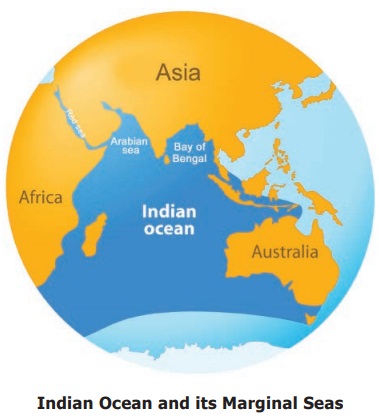
• 6° Channel
separates Indira Point and Indonesia
• 8° Channel
separates Maldives and Minicoy islands
• 9° Channel
separates Lakshadweep Islands and Minicoy islands
• 10°
Channel separates Andaman and Nicobar Islands
4. The Southern Ocean
The Southern Ocean surrounds
the continent of Antarctica and is enclosed by the 60°S latitude. It covers an area
of 21.96 million sq.km. It is bordered by the southern parts of the Pacific, the
Atlantic and the Indian Oceans. The Ross Sea, the Weddell Sea and the Davis Sea
are the marginal seas of this Ocean.
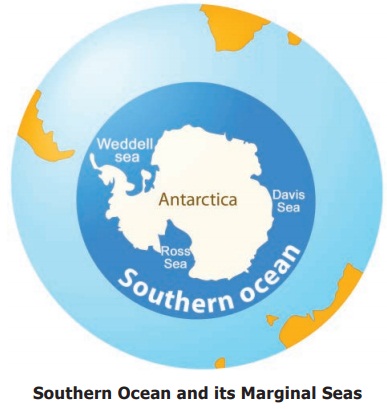
Farewell Island, Bowman
Island and Hearst Island are some of the islands located in this ocean. The water
in this ocean is very cold. Much of it is covered by sea ice. The deepest point
in this ocean is South Sandwich Trench with a depth of 7,235 m-.
HOTS:
When you travel from Japan to California,
which ocean would you travel across?
5. The Arctic Ocean
The Arctic Ocean is
the smallest ocean. It covers an area of 15.56 million sq.km. It lies within the
Arctic Circle. It remains frozen for most of the year. The Norwegian Sea, the Greenland
Sea, the East Siberian Sea and the Barents Sea are some of the marginal seas of
this ocean. Greenland, New Siberian Island and Novaya Zemlya Island are some of
the islands located in the Arctic Ocean.

The North Pole is situated
in the middle of the Arctic Ocean. The Eurasian Basin is the deepest point
in the Arctic Ocean, which is about 5,449 m- in depth.
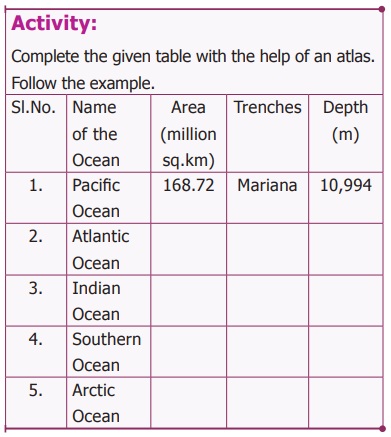
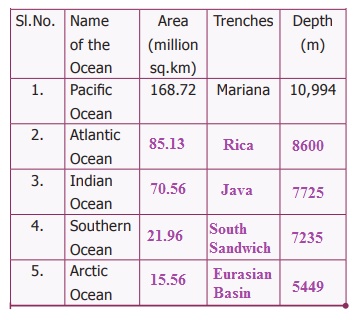
HOTS: When you arrange the continents in ascending order according to their size, which ranks third?
Related Topics